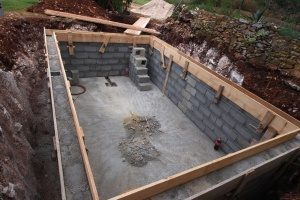 If you’re sick and tired of dealing with the hefty costs of having an inground pool, then it might be time to consider getting rid of it. While the initial removal process will cost you some money, it will practically pay for itself in the long term with the money you save by not having a pool. You will save money by eliminating costs such as higher insurance rates, pool maintenance fees, and replacement fees for old, damaged parts.
If you’re sick and tired of dealing with the hefty costs of having an inground pool, then it might be time to consider getting rid of it. While the initial removal process will cost you some money, it will practically pay for itself in the long term with the money you save by not having a pool. You will save money by eliminating costs such as higher insurance rates, pool maintenance fees, and replacement fees for old, damaged parts.
If you’re not invested in using your pool anymore, why should you keep investing your hard earned money into its upkeep? Owning a pool requires a lot of time, effort, and money to keep it in good condition, and if you’re no longer dedicated to your pool, you should strongly consider an in-ground swimming pool removal. Don’t hesitate to speak to a pool removal contractor for more information and to schedule your inground swimming pool removal service.
As a general rule, the cost of yearly pool maintenance can be calculated by taking 10 percent of the initial cost of pool installation, then dividing by 12. So if your pool $40,000 to install, your yearly cost of maintenance is $4,000 and your monthly cost is $330. Obviously, there can be other factors that affect how much your paying (such as repairs or additions like hot tubs and pool heaters), but regardless, that is a large chunk of money you’re spending on your pool on a regular basis. Having your inground swimming pool removed will give you some extra spending money each month, and save you tons of money in the long run.
How Does Inground Swimming Pool Removal Work?

It’s actually much easier to have your inground swimming pool removed than you might think. If you’ve never looked into how a swimming pool is removed, you may think it’s a very complicated process that takes a long time. In actuality, the entire process in total only takes about three to five days, providing city inspections don’t delay the work. Most of the time, a reputable pool removal contractor will have the licenses and permits taken care of before the project begins, ensuring that it takes only the required amount of time.
When it comes to inground swimming pool removal you have two options; a partial removal or a full removal. It’s important to do your research and make sure you are selecting the removal process that is the best for you.
 A partial removal will leave behind as many of the pool materials as possible and simply fill your pool with fill dirt. This is a great option if you’re looking to improve the appearance of your backyard. However, a partial removal is not the best option if you have other plans for the land on top of your pool. For example, a partially removed inground swimming pool cannot have anything substantial built on top of it because the ground will not be left stable enough to support any structures that would rest on top. This means you can forget about ever expanding your house onto that land or perhaps building a shed. Many people choose to get a partial removal mainly because it costs less than a full removal.
A partial removal will leave behind as many of the pool materials as possible and simply fill your pool with fill dirt. This is a great option if you’re looking to improve the appearance of your backyard. However, a partial removal is not the best option if you have other plans for the land on top of your pool. For example, a partially removed inground swimming pool cannot have anything substantial built on top of it because the ground will not be left stable enough to support any structures that would rest on top. This means you can forget about ever expanding your house onto that land or perhaps building a shed. Many people choose to get a partial removal mainly because it costs less than a full removal.
A full removal is always recommended but is only required if you have a vinyl pool built with walls made of steel. Full inground swimming pool removal is the most ideal option because it removes the entirety of the pool materials and fills the hole with fill dirt. This means that the land can be repurposed for other things, such as gardening or adding an addition to your house. While a full removal has a higher upfront cost, it allows the land to be returned to a normal state so that you can use it for any project you envision, leaving you with no limitations on how you choose to use your restored land.You Money
You Can Save Money
It’s no secret that an inground swimming pool is an extremely expensive feature of your house. It raises your insurance rates and liability coverage, comes with tons of maintenance and if anything should go wrong with your pool, you’re looking at very pricey repairs. Cutting these monthly costs alone will save you money in the long run. One example of eliminating costly pool expenses is a reduction in your homeowner’s insurance. Another is energy bill savings from an energy draining, expensive pool pump. Once you remove your pool, you will notice how much more money you are saving per month and per year without the hassle of pool maintenance and its related fees.
A neglected pool can begin to develop leaks that have the potential to compromise the stability of your pool. These could result in rusted equipment, and in extreme cases, soften the cement foundation of your pool. The water that escapes your pool can cause damage to your pool shell, pool deck, your house, and maybe even your neighbor’s house if the leak is bad enough. Not to mention your water bill will skyrocket. Perhaps you’re currently facing some of these problems and are debating whether or not to renovate or remove your pool. When weighing this decision you should remember that a renovated pool will eventually begin to develop problems and need further repair. A removed inground swimming pool will alleviate the stress of you ever having to worry about these problems again.
Not only are pools expensive by themselves, but they can make it much harder to sell your house. Home buyers usually have a strong opinion on whether or not they’re willing to deal with a pool, so if you have a pool you’re eliminating a large portion of people that could have otherwise been interested in your home if you had your swimming pool removed. Getting your inground swimming pool removed before selling your house has the strong potential to make your house more marketable. It’s also important to note that if you choose to have a partial pool removal, the potential home buyers must be notified because they cannot build on top of that land. Removing your inground swimming pool will give you many more options when it comes time to sell your home. The best thing to do is talk to an inground swimming pool removal contractor for more information and to schedule your pool removal.











































